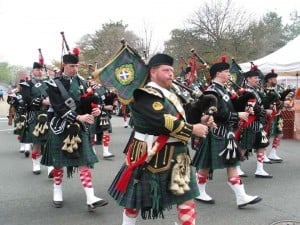Originally published on Change from Within and cross-posted here with their permission.
I recently attended a fundraiser event for Oyate Nipi Kte, an organization dedicated to the recovery of “Dakota traditional knowledge, including Dakota language, spirituality, ecology, oral tradition and life ways.”
At the event, Waziyatawin, Ph.D, called on White settlers who live on occupied Indigenous land to consider what it means to participate in resistance to White supremacy and continued colonization.
During a small group conversation, my friend Lex said something that has stuck with me, running through my mind daily since: “As White people, it’s important that we do the work to figure out who our people were before we were colonizers.”
It’s notable that Lex said this the day before St. Patrick’s day, during a weekend when countless people of all ethnic backgrounds donned green and drank green beer until they puked a verdant mess.
For me, reclaiming who my people were before we were colonizers means understanding my Irish, German, and Dutch heritage, yet I know next to nothing about my people and the cultures from whence they came.
Why? Well, because they became White.
Whiteness as a Construct
Despite the way it’s often discussed, race is not a biological concept, and it sure as hell isn’t static.
First, “Whiteness” didn’t exist when Europeans first came to North and South America. There were simply European landholders who held tight to power.
Over time, though, these European landowners needed a way to stave off slave and proletariat rebellions, so they invented this common “race” for some Europeans.
As laid out in Nell Irvin Painter’s “The History of White People,” at first, only certain Europeans (read: wealthy men from north-western Europe) were considered worthy of being in the club.
In the early-to-mid 19th century, though, the wealthy “White” folks realized they needed more allies who could serve in slave patrols and in menial labor positions, so groups like the Irish were slowly allowed to become “White” in order to offer these European immigrants/colonizers a pittance that would keep them from uniting with enslaved African people and Indigenous people.
From there, Whiteness was expanded again in the early-to-mid-20th century to include most Europeans and even to include Jews who, no matter where in Europe they were from, had been traditionally excluded from the “White” label.
The Wages of Whiteness
What this label offered was access: access to land (through things like the Land Grant Acts which was almost totally denied to anyone not considered White), access to education (both through better-funded public schools and the G.I. Bill, which was systematically denied to soldiers of Color), access to jobs (though anti-Irish and anti-Italian job discrimination did exist, it didn’t have the widespread impact that policies like Jim Crow did), and access to countless other little and big legs up in American life.
Despite common refrains from modern White people of Irish descent, these signs were rare.
But Whiteness came with a cost.
Becoming White meant leaving behind the cultural heritage of our people so that we could access the economic benefits, sometimes ones desperately needed, of the “American Dream” (aka the “Dream of White Supremacy”).
There’s a reason that I don’t speak a word of Gaelic, Dutch, or German. There’s a reason that I know next to nothing about the cultures from which my people came. There’s a reason that I don’t know the true reasons for why my people fled the land they always knew to see opportunities as colonizers in North America.
That reason is Whiteness.
When we look at race through this context, it is easier to understand Whiteness as more than a racial identity: It’s a system of privilege and oppression better known and understood as White Supremacy.
Privilege and Reclamation: Holding the Tension
We shouldn’t fool ourselves though. I’ve heard countless well-intentioned White folks say, “Well, if race is a social construct, then I’m not White. I’m human. Race is over!”
Just because race is socially constructed doesn’t mean that it’s not very real in the ways that it impacts nearly every aspect of our lives.
Those of us who come from Europe and have light skin can wish all we like that we were just “human,” but society will still see us as White.
Our name is likely to give us a leg up in job applications, and our skin color ensures us privilege in everything from the criminal justice system to representations in the media.
Thus, it is important that White people who strive to be anti-racist hold a tension: we must get in touch with our cultural heritage to understand our stake in ending White Supremacy through a connection to what we lost, but we also have to understand and remain accountable to the privileges that Whiteness affords us every day of our lives.
In some ways, this is a complex tension to hold.
After all, self-avowed White supremacists (lowercase because we’re referring to the individuals who espouse this ideology rather than the system) like to talk of “White genocide” and call for “White pride” by harking back to how few European-Americans understand their heritage.
While they are correct that this is a problem, they use this sacrifice made by Europeans in becoming White to uphold the system (Supremacy with a capital S).
In turn, it’s tricky to call for White people to reconnect with their heritage, for if it’s done without a commitment to anti-racist action, it can simply serve the cause of White supremacists.
After all, some who are calling on White people to reconnect to their heritage are the same ones wearing “White Pride” t-shirts, as they conflate Whiteness with the cultural heritage that had to be abandoned in order to become White.
Note the use of the Gaelic Cross to encourage White Pride
That’s why I love the work of my friend Ryan Williams-Virden. Strongly connected to his Irish heritage, he calls for more than shamrock hats and green beer on St. Patty’s Day.
He calls for an investigation of the roots of Irish emigration and for an understanding of Irish resistance to British colonial oppression in hopes of helping Irish-Americans find empathy for and solidarity with racially oppressed people of Color in the United States.
Acknowledging and acting against the system that privileges my identity while reconnecting with who my people were before they were oppressors, colonizers, and/or beneficiaries of White privilege allows for a powerful transformation of my understanding of identity.
Knowing my cultural heritage helps me grasp one more thing that I have at stake in ending White Supremacy, yet I still am able to remain accountable to the privileges my White identity affords me.
As a result, I can better ensure that my anti-racist actions are not paternalistic (something I’ve surely been guilty of plenty of times in my life).
In my own family and history, this means understanding my family as settlers who built their lives on land in South Dakota and West Virginia that was stolen from Indigenous people and who, in buying into the system of Whiteness, have built the “Dream of White Supremacy” for ourselves.
But it also means understanding that my people came here for a reason, and uncovering those reasons has the potential to deepen my commitment to ending White Supremacy.
Not All White People Are Bad, But Whiteness Surely Is
Last night, I had the incredible pleasure of sharing space and time with some powerful activists and the students of Cristo Rey Jesuit High School here in Minneapolis in processing the film Crash.
After a few students of Color qualified their statements about racism with, “Not all White people are bad, but…,” activist, therapist, and educator Harry Ford gave the students permission to stop qualifying their truth.
“You don’t need to say ‘Not all White people…’ when talking about Whiteness,” he implored the brilliant young minds.
Harry said it perfectly.
We must make a distinction between individual White people and Whiteness.
***
As an individual White person, I can surely act against White Supremacy, but I also benefit every day from its existence as a system of oppression.
However, this doesn’t preclude me from connecting to my cultural identity beyond the poisonous system of Whiteness.
[do_widget id=’text-101′]
Jamie Utt is a Contributing Writer at Everyday Feminism. He is the Founder and Director of Education at CivilSchools, a comprehensive bullying prevention program, a diversity and inclusion consultant, and sexual violence prevention educator based in Minneapolis, MN. He lives with his loving partner and his funtastic dog. He blogs weekly at Change from Within. Learn more about his work at his website here and follow him on Twitter @utt_jamie. Read his articles here and book him for speaking engagements here.
Search our 3000+ articles!
Read our articles about:
Our online racial justice training
Used by hundreds of universities, non-profits, and businesses.
Click to learn more























